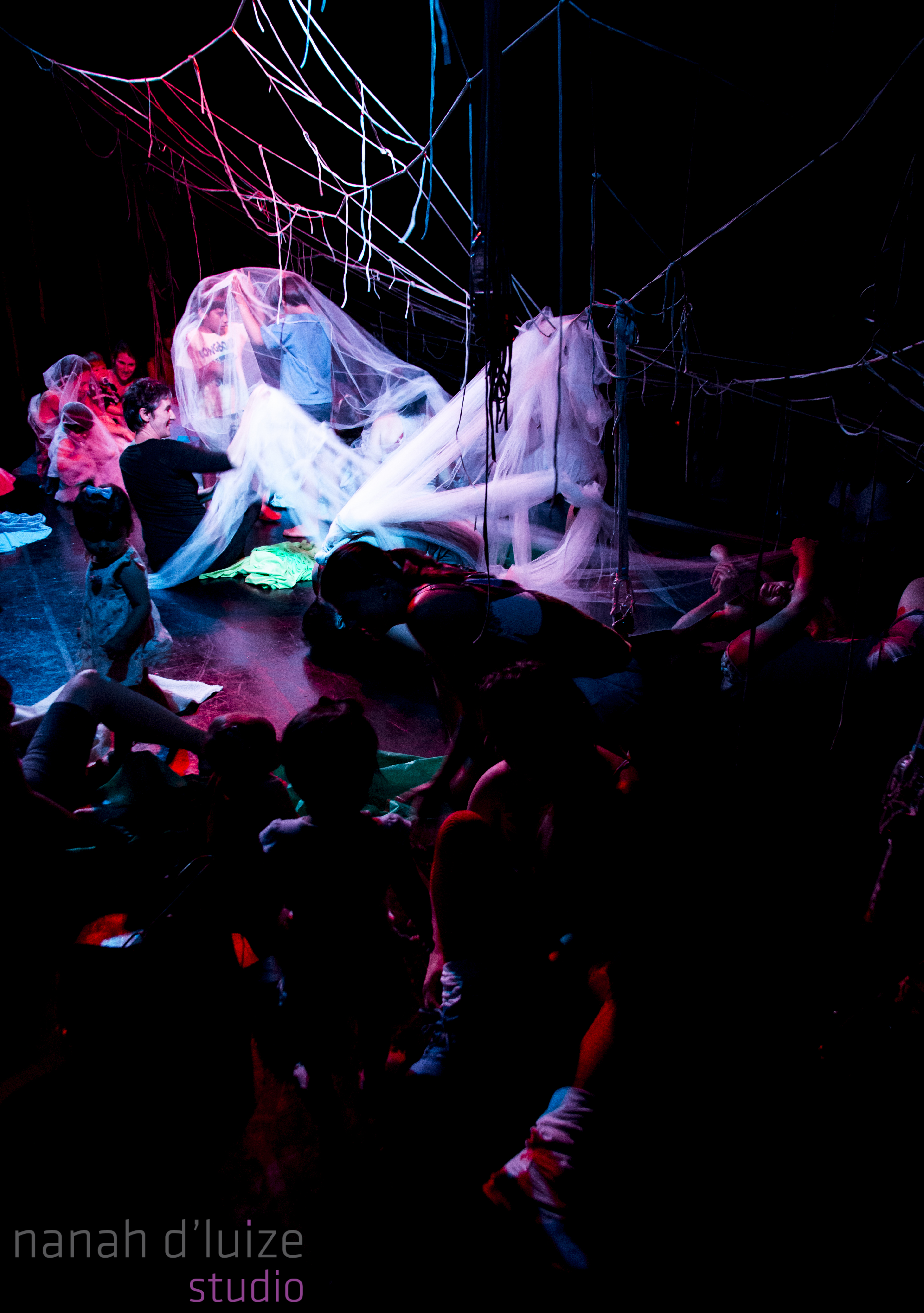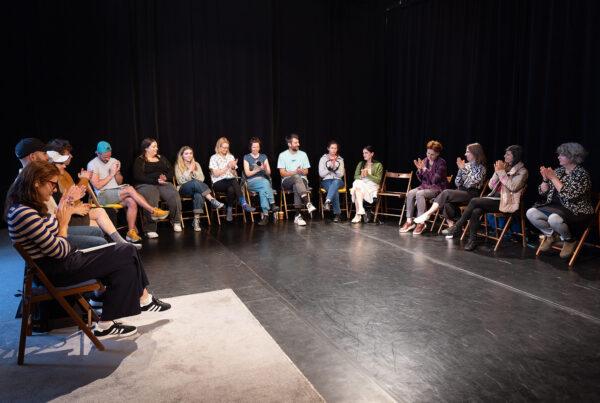Body as the starting point.
In this article, we would like to share the unpredictable experience of having two amazing artists from Australian’s Polyglot Theater; the artistic director, Sue Giles and the dancer Penny Baron, who crossed the ocean to develop ten days of an artistic residency with the young independent NúcleoDedalos, company of scenic art and movement research and development, based in the city of Piracicaba, São Paulo, Brazil. Polyglot is a pioneer in experimental/interactive theater and its work is inspired by the child´s universe; NúcleoDedalos, on the other hand, under the artistic direction of Luiza Banov, emerges from the need of dialogue with contemporary art forms, having dance as its starting point.
In order to take greater advantage of the Australian artists, the NúcleoDedalos had already prepared a scene of approximately twenty minutes, which would work as a poetic landscape to guide the creative process of the encounter. The preparation process began two months before the residence with Luiza Banov (project’screator, artistic director, dancer), Ivy Calejon (project’s creator, scenographer), Julia Giannetti (dancer) Rodrigo Oliver (dancer) Estér Ferreira Leite (Musician) and Jayana Gandhy (Musician). The practices were opened latter to the whole community and all the residency steps took place at SESC – Serviço Social do Comércio, Piracicaba, São Paulo headquarters.
The river was our great artistic motivation; we desired to speak about our region and our hometown, but above all we understood Piracicaba’s river as a mirror of life, the water that generates, conducts, and feeds. Therefore, recycled materials were used for the scenario, which reflects the concern with the ecological aspects inherent to our society reality. Plastic bottles filled with waters in different shades of red— alternating between earthy brown, the vibrant blood of the uterus, and the mud which dilutes in the river water—drew parallels to the dirt and garbage that increasingly surpasses the splendid scenarios of nature.
 As a reflection of weaving, we used knit yarns that made almost a net of fishing from the top of the stage branching out to the audience, allowing an exuberant integration between what happened in the scene and the audience. Moreover, the integration of the audience and interactivity was a characteristic part and a clear objective of scenic research. The soundtrack was an important aid used to mimic the creation, and the possibility of build together with music allowing the event a special energy which broadened the actions and perceptions related to it. Thus, the questions and responses relationship between performance and audience gained space and body for the event.
As a reflection of weaving, we used knit yarns that made almost a net of fishing from the top of the stage branching out to the audience, allowing an exuberant integration between what happened in the scene and the audience. Moreover, the integration of the audience and interactivity was a characteristic part and a clear objective of scenic research. The soundtrack was an important aid used to mimic the creation, and the possibility of build together with music allowing the event a special energy which broadened the actions and perceptions related to it. Thus, the questions and responses relationship between performance and audience gained space and body for the event.
The opportunity of this work allowed an intense interactive content. A dance that first has appeared as a sequential phrase of movement, almost like a bi-dimensional painting in movement, passes to a three-dimensional version and invites the public to interact, interfere and build the proposed painting.
Having plastic bottles as part of interaction, several games could be elaborated from the relationship established with the public; Among them rhythmic noises that happened when shaking the bottles; bring down bottles; stacking bottles; follow the master among so many others. These dynamic games happened through questions and answers established in the relationship of the interpreters with the spectators. In other words, born from this relation.
We understand that intercultural exchange with regards to globalization can really be a positive issue and transcend our technological time. Contemporary research does not have enough tools to account for the subjective issues of this context, since it resides in a mixture of traditions and technological innovations.
This experience is quite new , since not only does the artist interact with the audience, but the viewer is invited to be an active part of the scene; Subtly the “invitation” is performed in the scenic event itself, and the viewer may or may not enter the game. The methodology of the work was very positive and opened new pathways for NúcleoDedalos work as new possibilities to our artistic development were introduced.
This view of a society completely interconnected with individuals, but still respecting their singularities, has, in turn, a spiritual character: in this sense creation operates in a scope beyond the material. It transits between worlds, it stamps the universe and it can transform souls. There is a fundamental role, among many others, of artistic making, of the creation of subjectivity, which acts directly in the essence, allowing direct interference in the soul.
The opportunity of this intercultural exchange with regards to globalization, artistry, power, and cultural norms encourages, even outside the great centers, to develop art. As this experience showed, trough the possibility of a young group of artists in the country side of São Paulo/Brazil, being able to have as guest such a wonderful and experienced director such as Sue Giles and also the talented dancer Penny Baron, representing the recognized Polyglot Theater, makes us believe that it is possible to involve large centers of art in development, significant productions from other parts of the world, to dialogue, to bring this knowledge and culture to our region.
By Luiza Banov
Biography – Dancer, choreographer and body educator. Bachelor and graduated in Dance, master in Arts (2011) by Unicamp/Brazil. Currently Ph.D. in Performing Arts at ECA-USP/ SP Brazil.
SAYONARA PEREIRA – PHD. Professor, researcher, adviser, and director ofAPETT – Laboratory for Research and Studies in Tanz Theatricalities at the University of São Paulo – ECA / USP. Post PhD (2016) Freie Universität Berlin-Germany, Post PhD (2009), and PhD (2007) in Arts-Dance at the University of Campinas (UNICAMP) -SP Brazil. Graduated in Dance Pedagogy at the Hochschule Für Musik und Tanz-Köln / Germany (2003).



